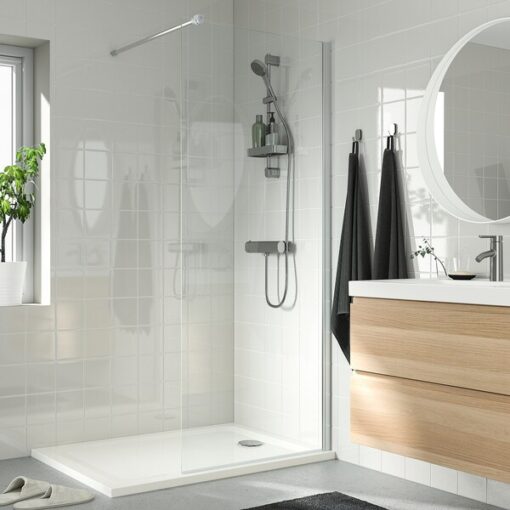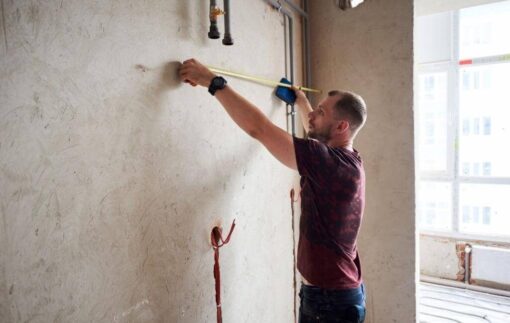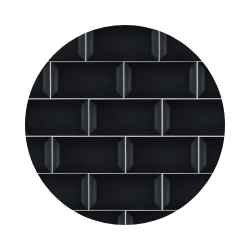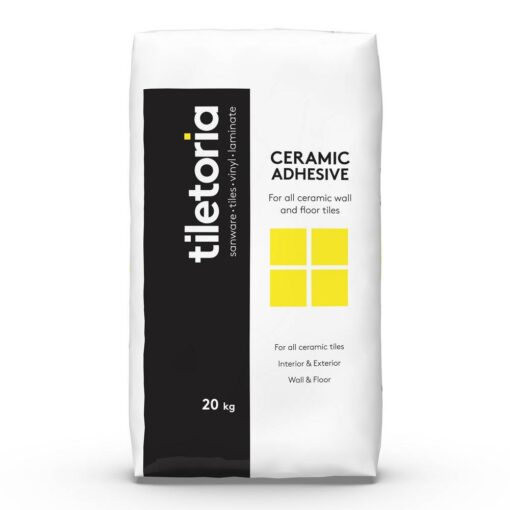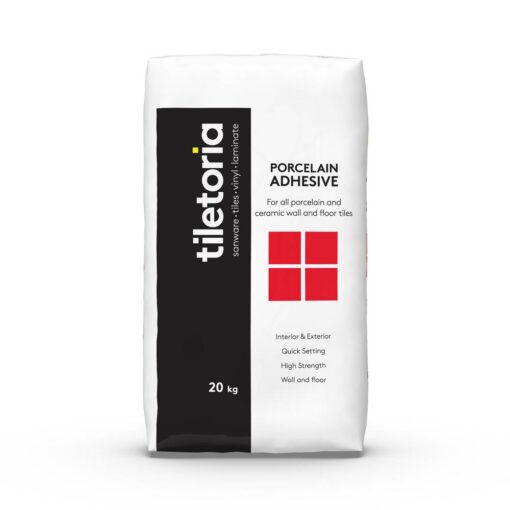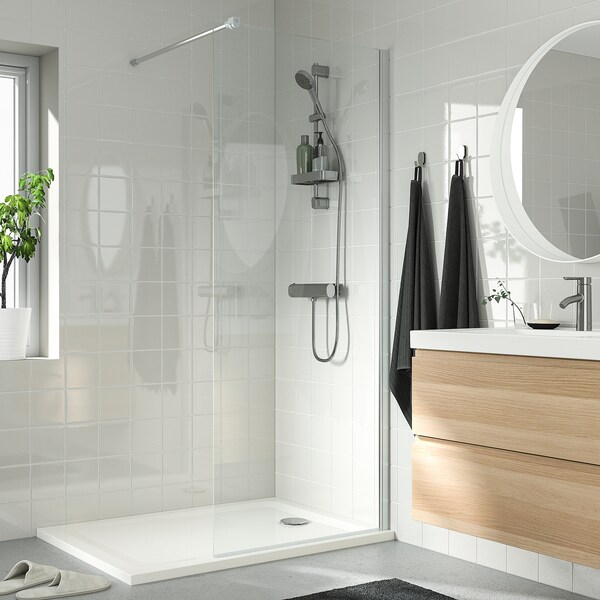
bathroom, blog, how to articles
Choosing your shower and shower doors is crucial for creating a luxurious and functional bathroom space. A well-chosen shower not only enhances the aesthetics but also ensures a seamless experience.
Prefer watching over reading? Explore this topic by tuning in to the episode on Tiletoria Trends here.
The most important consideration
Measure your available space before selecting your bathroom shower doors, as the choice can significantly impact functionality. For instance, choosing a pivot door might not work in a small bathroom with limited space for the door to open.
Shower Curtains vs Shower Doors
One aspect that significantly elevates your experience and aesthetic is the choice between curtains and doors. Unlike curtains, doors provide a water-tight enclosure, ensuring a cleaner bathroom and a more enjoyable bathing experience.
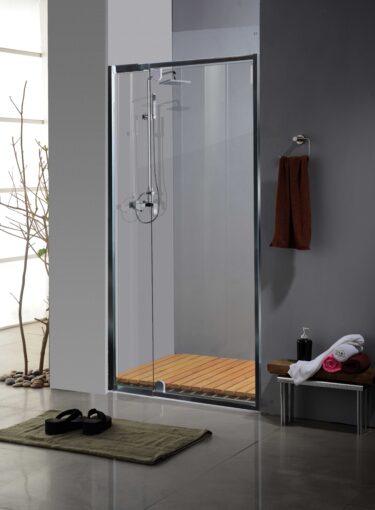
Shower Screen
A typically shower enclosure, offers a contained space for bathing. A glass panel or a shower screen, open on one side, provides a minimalistic and open feel to your bathroom. This choice conveys the sensation of a walk-in shower. Remember, the choice impacts not only functionality but also the overall aesthetics of your space.

Clear Glass vs Frosted glass
Clear shower glass panels provide a sleek look, allowing you to showcase the beauty of your tiles and fixtures.
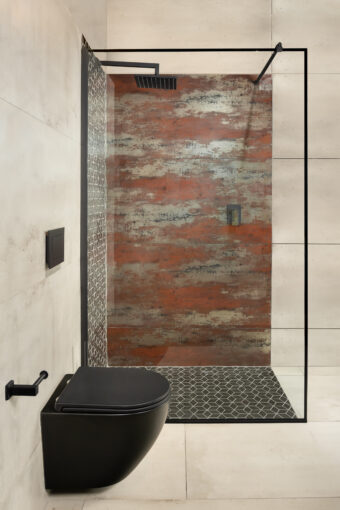
On the other hand, frosted glass panels add a layer of privacy while still allowing natural light to filter through. Frosted glass shower doors also offer decorative patterns which can add character into your space.

If you’re considering frosted shower doors but not quite ready for a commitment, consider Robin Sprong Shower Panel Vinyl. These easy-to-apply vinyl stickers offer a frosted glass effect. They are long-lasting, and leave absolutely no damage or residue upon removal. You can also fully customize them to suit your unique style and taste.
Explore our range here.
Frameless
For those who appreciate a clean, minimalist look, frameless shower doors are the epitome of sophistication. With no visible frames, these doors provide an unobstructed view, adding a touch of luxury to your space.

Framed and Semi-Frameless
Framed shower doors, with a sturdy metal frame, provide added stability and support. Semi-frameless doors combine the best of both worlds, offering a sleek design with a minimal frame. These options are excellent choices for those seeking a balance between durability and traditional aesthetics.

Different types of shower doors
Sliding doors
Suitable for compact spaces, sliding shower doors exude simplicity and functionality. Their smooth gliding mechanism ensures a hassle-free entry and exit, making them a practical choice for smaller bathrooms.
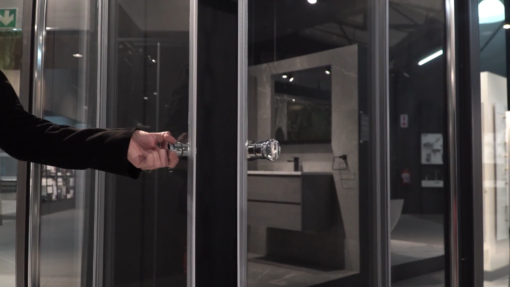
Pivot doors
Offering a traditional yet stylish look, pivot shower doors open on a pivot hinge. They provide a classic aesthetic while ensuring ease of use. Remember, these may not be suitable for smaller bathrooms with limited space.
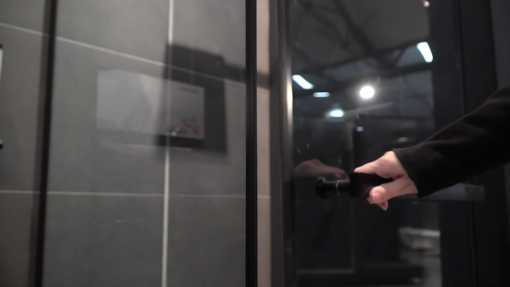
Folding doors
Folding shower doors are perfect for tight spaces. Their accordion-like design allows them to fold neatly against the wall, offering convenience without compromising on style.
Corner Entry Showers
If space is a concern, corner shower doors optimize the layout of your bathroom. They fit seamlessly into corners, making the most of available space while adding a unique visual appeal.

Glass vs. Plastic vs. Acrylic – Material Considerations
When choosing your material, it’s essential to weigh the pros and cons.
Glass shower doors are durable and easy to clean but can be heavy and expensive. On the other hand, acrylic and plastic doors are lightweight and budget-friendly but may not be as durable as glass. Consider the material that best suits your budget and needs.
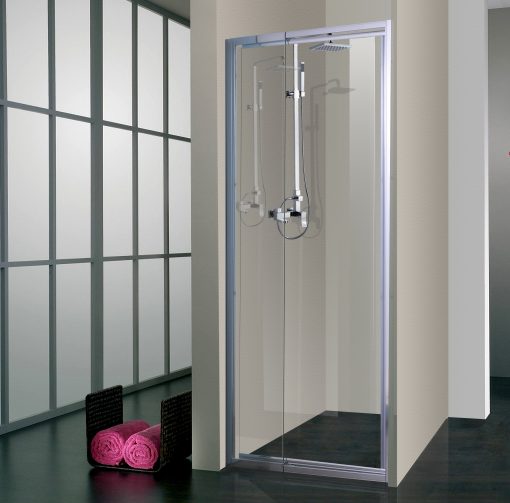
Colours – Setting the Tone
The colour of your shower door can significantly impact the overall aesthetic. Black shower doors offer a bold and modern look, while white shower doors evoke a sense of cleanliness and simplicity. Choose a colour that complements your bathroom’s theme and overall aesthetic.

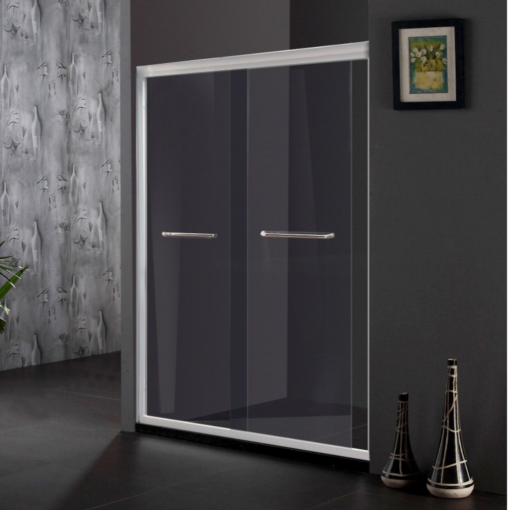
Specials
To sweeten the deal, we regularly offer shower and shower door specials throughout the year. Keep an eye on our social media platforms for real-time updates on discounts and promotions.
For an exclusive heads-up, sign up for our newsletter, and be the first to know about upcoming sales. You’ll also get an exclusive sneak peek at all discounted products before their public release.

Selecting the perfect shower is not only about functionality. It involves enhancing your bathroom’s aesthetic and transforming your daily routine into a luxurious experience. The diverse range available allows you to tailor your choice to fit both your space and style.
Remember, the key is to strike a balance between practicality and elegance. So, measure your space, consider your preferences, and let your shower be a statement of sophistication!
View our range of showers for sale and shower doors for sale
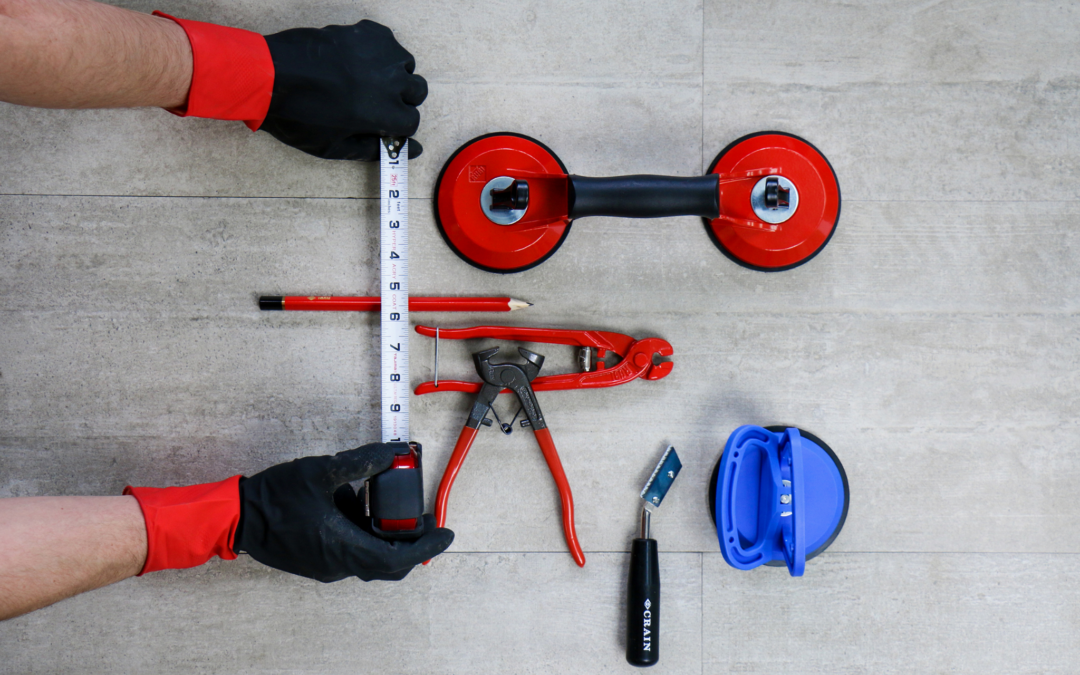
blog, commercial blog, how to articles
Embarking on a tile installation project can be both exciting and daunting. Whether you’re revamping your kitchen, bathroom, or any other space, the success of your project hinges on the tools and accessories you use. Choosing the right equipment can make the difference between a flawless installation and a frustrating ordeal. In this comprehensive guide, we’ll explore the crucial tools and accessories that are indispensable for a successful tile installation.
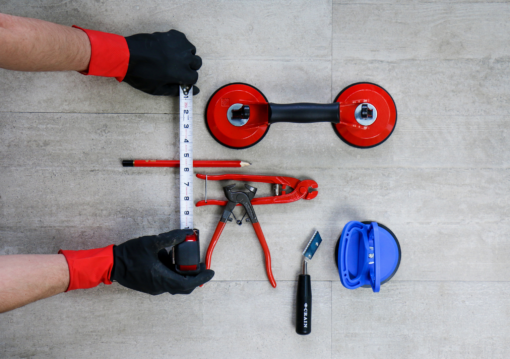
- Measuring and Layout Tools:
Accurate measurements and precise layout are the foundation of any successful tile installation. Invest in quality measuring tools, such as a tape measure, straight edge, and a framing square. A laser level is an excellent addition to ensure a level and straight installation.
- Tile Cutter:
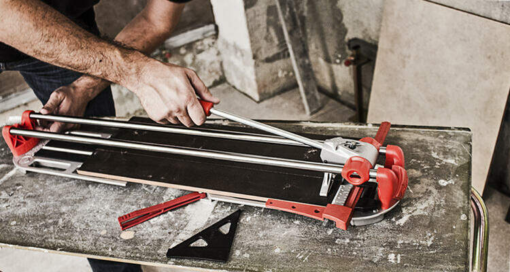
A tile cutter is a must-have tool for any tile installation project. There are various types of tile cutters available, including manual snap cutters, electric wet saws, and handheld tile cutters. Choose the one that best suits your needs and the type of tiles you’re working with.
- Tile Nippers:
Tile nippers are essential for making small, detailed cuts or shaping tiles to fit around obstacles. They are especially handy when dealing with ceramic or porcelain tiles that may require slight adjustments for a perfect fit.
- Tile Spacers:
Achieving consistent and even spacing between tiles is crucial for a professional-looking finish. Tile spacers come in various sizes and are used to maintain uniform gaps, ensuring that the tiles are properly aligned during installation.
- Trowels and Notched Trowels:
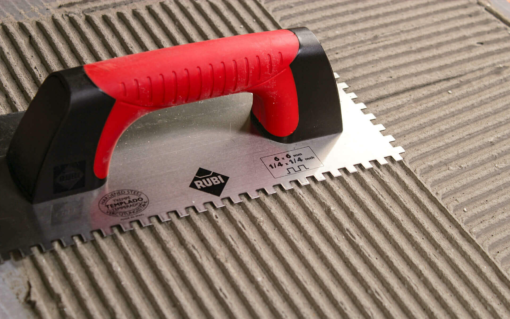
Trowels are used to spread adhesive or mortar evenly on the substrate before laying the tiles. Notched trowels have ridges that help create uniform grooves in the adhesive, promoting better adhesion and reducing the risk of air pockets.
- Grout Float:
Once the tiles are in place, a grout float is used to apply and press grout into the spaces between tiles. Choose a rubber float for standard applications or a harder plastic float for epoxy grouts.
- Rubber Mallet:
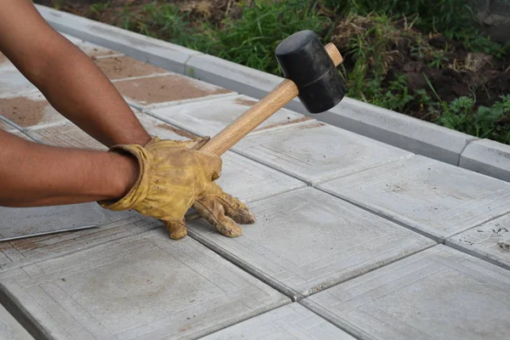
A rubber mallet is essential for gently tapping tiles into place without damaging them. It’s particularly useful when adjusting tiles that may be slightly uneven or need to be leveled with neighboring tiles.
- Wet Saw:
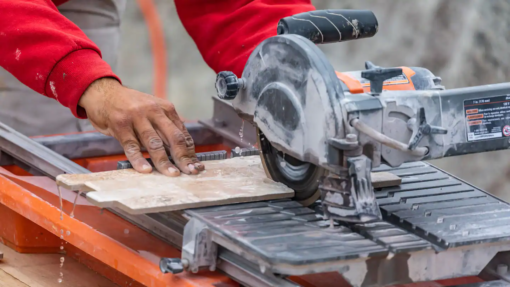
For cutting through hard materials like natural stone or porcelain tiles, a wet saw is indispensable. The continuous flow of water helps keep the blade cool and minimizes dust, ensuring clean and precise cuts.
- Knee Pads:
Tile installation often involves spending a significant amount of time on your knees. Invest in quality knee pads to provide comfort and protection, reducing strain on your joints during the installation process.
- Safety Gear:
Protect yourself with the appropriate safety gear, including safety glasses and gloves. Tile cutting and installation can generate dust and debris, and protecting your eyes and hands is essential for a safe working environment.
- Mixing Drill and Paddle:
For large tile installations, using a mixing drill with the appropriate paddle attachment is essential for efficiently mixing mortar or adhesive. This ensures a consistent and lump-free mixture, promoting a secure bond between the tiles and the substrate.
- Sponges and Buckets:
Keep a bucket of clean water and a sponge handy for wiping off excess grout and adhesive during and after the installation. A clean sponge helps achieve a professional finish by preventing grout haze and residue on the tiles.
- Sealer and Applicator:
Depending on the type of tile you’re using, applying a sealer may be necessary to protect against stains and moisture. Invest in a high-quality sealer and the appropriate applicator to ensure thorough and even coverage.
- Tile Leveling System:
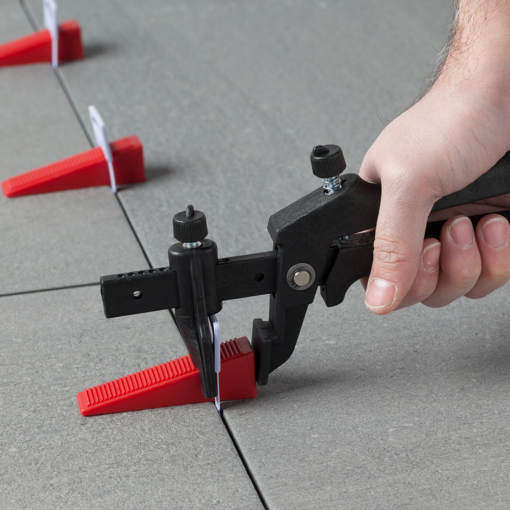
To achieve a perfectly flat and level surface, consider using a tile leveling system. These systems use clips and wedges to ensure that tiles are flush with each other, preventing lippage and creating a seamless finish.
- Caulk and Caulk Gun:
Finish the edges of your tile installation with a high-quality caulk that matches the grout colour. A caulk gun makes the application process clean and precise, providing a professional look while also sealing gaps and preventing water intrusion.
A successful tile installation requires more than just the tiles themselves. The right tools and accessories play a crucial role in achieving a professional and long-lasting result. By investing in high-quality equipment and taking the time to plan and measure accurately, you’ll set the stage for a smooth and successful tile installation project. Whether you’re a seasoned DIY enthusiast or a professional contractor, having the essential tools at your disposal will make the entire process more efficient and enjoyable.

blog, commercial blog, how to articles, walls
Mosaic tiles have an undeniable charm that can add a touch of artistry and sophistication to any space. Whether you’re planning to transform your kitchen backsplash, bathroom, or any other area in your home, installing mosaic tiles can be a fulfilling DIY project if done correctly. In this comprehensive guide, we’ll walk you through the steps to install mosaic tiles like a professional, ensuring a stunning and lasting result for your home improvement project.
Why Choose Mosaic Tiles?
Before we dive into the installation process, it’s essential to understand why mosaic tiles are a popular choice for homeowners. Mosaic tiles are characterized by their small size and intricate designs. Here are some reasons to consider them:
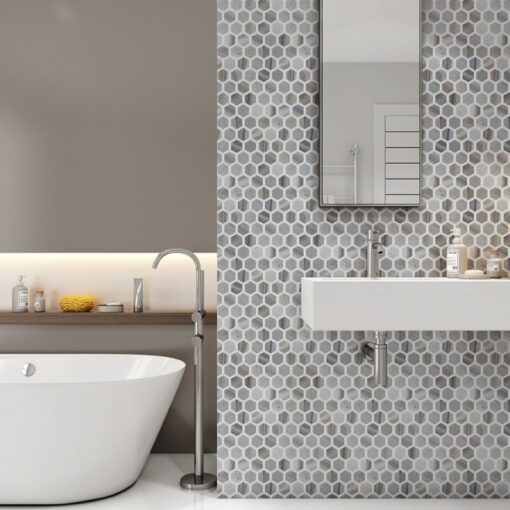
- Visual Appeal: Mosaic tiles come in a wide range of colours, materials, and patterns, allowing you to create unique and eye-catching designs. Their small size often makes them ideal for detailed and intricate patterns.
- Versatility: You can use mosaic tiles in various applications, including backsplashes, showers, floors, and even as decorative accents. They can be applied to almost any surface that can support tiles.
- Durability: Mosaic tiles are typically made from materials like glass, ceramic, porcelain, and natural stone, making them durable and long-lasting. They are resistant to moisture, stains, and wear and tear.
- Easy Maintenance: Mosaic tiles are relatively easy to clean and maintain, thanks to their non-porous surface. A simple wipe-down or mopping will keep them looking new.
- Value Addition: Installing mosaic tiles can increase the value of your home. Potential buyers often find them attractive and appreciate the attention to detail they bring to a space.
Now that you know why mosaic tiles are a great choice let’s get into the step-by-step guide for a professional installation.
Tools and Materials You’ll Need
Before you begin the installation, gather the following tools and materials to ensure a smooth and efficient process:
Tools:
– Mosaic tiles
– Tile adhesive
– Tile spacers
– Tile cutter or nipper
– Notched trowel
– Grout
– Grout float
– Tile sponge
– Bucket for mixing grout
– Level
– Measuring tape
– Pencil
– Safety glasses and gloves
– Drop cloth or plastic sheeting
– Sandpaper
– Masking tape (if needed)
Step 1: Prepare the Surface
Before you start installing mosaic tiles, it’s crucial to ensure that the surface you’re tiling is clean, smooth, and free from any dust or debris. The quality of your installation depends on a well-prepared surface. If you’re working on a wall, patch any holes or imperfections. If you’re tiling a floor, make sure it’s level.
Tips:
– Repair any existing damage or imperfections on the surface before starting.
– Sand down rough or uneven areas to create a smooth and even substrate for your tiles.
– Cover surrounding areas with a drop cloth or plastic sheeting to protect them from adhesive and grout spills.
Step 2: Plan Your Layout
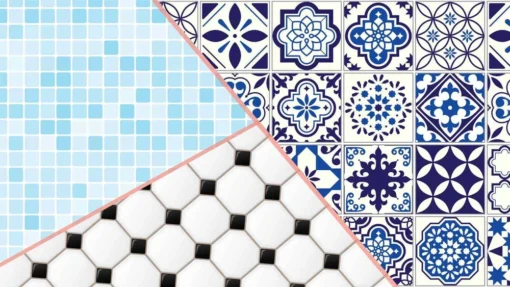
Before you start attaching tiles, it’s a good idea to plan the layout to avoid potential problems later. Here’s how to do it:
- Dry-Fit Your Tiles: Lay out your mosaic tiles on the surface without adhesive to get a sense of how they will look. Experiment with different arrangements and patterns to find the one that suits your aesthetic preferences.
- Measure and Mark: Use a measuring tape and pencil to mark the center point of your surface. This will serve as your starting point for tile installation.
- Create a Grid: Use a level and pencil to create a grid of guidelines that intersect at the center point. This grid will guide your tile placement and ensure a balanced design.
- Adjust and Cut Tiles: Depending on your layout, you may need to trim tiles to fit along the edges and borders of your surface. Use a tile cutter or nipper for this purpose.
Tips:
– Experiment with different arrangements to find the one that suits your aesthetic preferences.
– Make sure that the layout is symmetrical and well-balanced, especially if you’re working with a focal point like a backsplash or a decorative feature.
Step 3: Mix Tile Adhesive
Next, you’ll need to prepare the adhesive that will hold your mosaic tiles in place. Follow the manufacturer’s instructions on the adhesive packaging to create a mixture with the correct consistency.
Tips:
– Mix small batches of adhesive as you work to prevent it from drying out before you can apply the tiles.
– Wear safety glasses and gloves when handling adhesive to protect your eyes and skin.
Step 4: Apply Tile Adhesive
With your adhesive mixture ready, it’s time to apply it to the surface in preparation for your mosaic tiles. Here’s how:
- Work in Small Sections: Begin by spreading a layer of adhesive on a small section of the surface. The idea is to work on an area you can tile in about 15-20 minutes to prevent the adhesive from drying out.
- Use a Notched Trowel: Use a notched trowel to spread the adhesive evenly over the surface. The notches on the trowel create ridges that help the tiles adhere properly. The size of the notches should match the size of your tiles.
- Apply at a 45-Degree Angle: Hold the trowel at a 45-degree angle and apply pressure to ensure that the adhesive is evenly distributed.
Tips:
– Work methodically and avoid applying adhesive to a larger area than you can tile within the specified time to maintain adhesive tackiness.
– Use the notched side of the trowel to create ridges in the adhesive for better tile adhesion.
Step 5: Install Mosaic Tiles
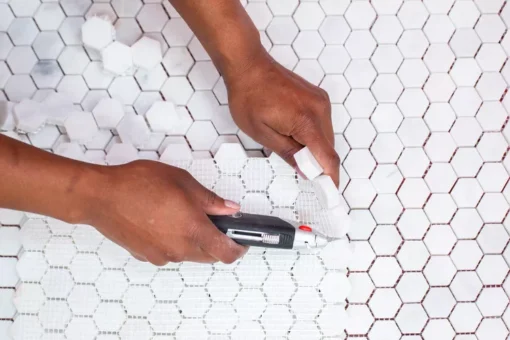
Now comes the exciting part – attaching your mosaic tiles to the adhesive. Follow these steps for a professional-looking installation:
- Press Tiles into Adhesive: Carefully press each mosaic tile into the adhesive, following the grid you created during the layout planning. Ensure that each tile is level and properly aligned with the others.
- Use Tile Spacers: Insert tile spacers between the tiles to maintain even gaps. The size of the spacers will depend on your design and the desired spacing between tiles.
- Trim Tiles When Necessary: You may need to trim tiles to fit along the edges or around obstacles like electrical outlets or plumbing fixtures. Use a tile cutter or nipper for this purpose.
Tips:
– Check your layout and grid lines regularly to ensure that you’re staying on track and that your mosaic design remains balanced.
– Double-check tile alignment and spacing to create a polished look.
Step 6: Allow Adhesive to Dry
After you’ve successfully attached all your mosaic tiles to the adhesive, it’s crucial to allow the adhesive to dry thoroughly. Follow the manufacturer’s instructions for the recommended drying time, which is typically around 24 hours. The drying time may vary based on factors like humidity and temperature.
Tips:
– Avoid any physical contact with the tiles during this drying period to prevent accidental displacement.
Step 7: Prepare Grout
Grout is the material that fills the gaps between your tiles and gives your installation a polished, finished look. Here’s how to prepare it:
- Select the Right Grout: Choose a grout colour that complements your mosaic tiles and the design you’ve created. Grout comes in various colours, so take your time to select the one that enhances your design. Access our guide to Choosing The Right Grout Colour here.
- Mix the Grout: Follow the manufacturer’s instructions to mix your grout. Typically, you’ll need to combine the grout powder with water until you achieve a smooth, thick consistency, similar to peanut butter.
Tips:
– Make sure to choose the right colour of grout that complements your mosaic tiles.
– Prepare a reasonable amount of grout to work with, as it should be used quickly to maintain its workability.
Step 8: Apply Grout
Applying grout is a crucial step that will not only fill the gaps between your mosaic tiles but also ensure their stability. Here’s how to do it:
- Work in Small Sections: Just as with adhesive, it’s best to work in small sections when applying grout. This allows you to manage the process more efficiently.
- Spread Grout: Use a grout float to spread the grout evenly over the tiles. Hold the float at a 45-degree angle to the tiles to pack the grout into the gaps.
- Hold the Float at an Angle: To ensure the grout gets into the gaps and covers the entire tile surface, hold the float at a slight angle and apply pressure as you move it.
Tips:
– Work methodically to ensure that the grout is evenly applied to all areas of your mosaic tiles.
– Don’t rush this step, as it’s essential to get the grout into all the gaps and ensure a secure bond.
Step 9: Remove Excess Grout
Once you’ve applied the grout, it’s time to clean up the excess to reveal your beautifully installed mosaic tiles. Here’s what you need to do:
- Dampen a Tile Sponge: Wet a tile sponge and wring out the excess water. You want the sponge to be damp but not soaking.
- Wipe the Tiles: Gently wipe the tiles with the damp sponge to remove excess grout from the tile surfaces. Rinse the sponge frequently to avoid smearing grout over the tiles.
- Clean Grout Lines: Use the sponge to shape and clean the grout lines, ensuring they are even and smooth.
Tips:
– Work carefully but quickly to prevent the grout from hardening on the tiles.
– Rinse the sponge thoroughly to avoid spreading grout residue on the tiles.
Step 10: Final Cleaning
Once you’ve removed most of the excess grout from the tiles, allow the grout to set for a short period before doing a final cleaning. Here’s how to do it:
- Allow Grout to Set: Let the grout dry for a short time, typically for about 15-30 minutes, or as recommended by the grout manufacturer. The grout should become slightly hazy.
- Buff Tiles: Using a clean, dry cloth or a lint-free rag, gently buff away the remaining grout haze from the tiles. This will reveal the full beauty of your mosaic tiles.
Tips:
– Be patient while buffing the tiles to avoid scratching the surface.
Step 11: Seal the Grout (Optional)
While this step is optional, it’s recommended if you want to protect your grout from staining and make maintenance more manageable. Sealing the grout creates a barrier that prevents moisture and debris from penetrating the porous material. Follow these steps if you choose to seal your grout:
- Select a Grout Sealer: Choose a high-quality grout sealer that suits your needs. Grout sealers come in two main types: penetrating sealers and membrane-forming sealers. Penetrating sealers are absorbed into the grout, providing protection without altering its appearance, while membrane-forming sealers create a protective film over the grout.
- Apply the Sealer: Follow the manufacturer’s instructions for applying the sealer. Typically, you’ll use a brush, roller, or applicator bottle to spread the sealer over the grout lines. Be careful not to get sealer on the tile surfaces.
- Wipe Off Excess Sealer: After allowing the sealer to set for a few minutes (as per the manufacturer’s recommendations), use a clean, dry cloth to wipe off any excess sealer from the tile surfaces.
Tips:
– Make sure the grout is fully dry before applying the sealer.
– Some sealers may require multiple coats, so be sure to follow the product’s specific instructions.
Step 12: Enjoy Your Newly Tiled Surface
With the grout fully cured, which typically takes 24-72 hours, your mosaic tile installation is complete. Step back and admire your professional-looking mosaic tile work that enhances the beauty of your space. You’ve now added a touch of artistry and sophistication to your home.
Tips:
– Clean and maintain your mosaic tiles regularly to keep them looking their best.
– Consider using a tile and grout cleaner to remove dirt and stains without damaging your installation.
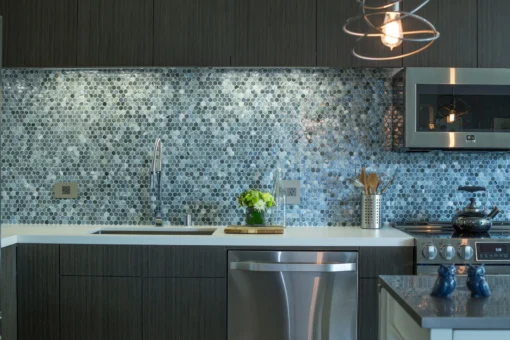
Installing mosaic tiles may seem like a daunting task, but with the right tools, materials, and a methodical approach, you can achieve professional-looking results. The beauty of mosaic tiles lies in their ability to add a unique and elegant touch to any room, and this step-by-step guide can help you achieve just that.
Whether you’re a seasoned DIY enthusiast or a first-time tiler, follow this guide, take your time, and enjoy the process. With patience and attention to detail, your mosaic tile installation will be a stunning addition to your home, elevating the aesthetics of your space and adding value to your property.
Now that you’ve learned how to install mosaic tiles like a pro, it’s time to roll up your sleeves and get started on your own tiling project. Whether you’re revamping your kitchen, upgrading your bathroom, or creating a beautiful mosaic masterpiece, you’re well-prepared for success. Happy tiling!

blog, floors, how to articles, walls
Master the art of tile maintenance and cleaning with our comprehensive guide to ensure your tiles stay sparkling and fresh.
Tiles can transform your space with their elegance and functionality. Whether you have glazed or unglazed tiles, proper maintenance is essential to preserve their beauty and longevity. In this guide, we’ll walk you through the steps of cleaning and maintaining your tiles, whether they’re in your bathroom, kitchen, or any other area of your home. With the right approach, your tiles will continue to shine for years to come.

Regular Cleaning Routine for Glazed Tiles
Glazed tiles are a popular choice for various applications, including walls, baths, and showers.
To keep them looking their best, follow these steps:
1. Choose the Right Cleaner: Opt for an all-purpose, low VOC, household or commercial cleaner that is compatible with grout joint cleaning. Avoid harsh chemicals, as they can damage the tile’s glazed surface and the grout.
2. Application and Agitation: Use a cotton mop, cloth, sponge, or non-metallic brush to apply the cleaner to the tile surface. Gently agitate the cleaner to remove soap scum, hard water deposits, and mildew.
3. Rinse and Dry: After cleaning, rinse the area with clean water to remove any residue. Thoroughly dry the tiles to prevent water spots.
Unglazed Tiles Require Special Care
Unglazed tiles, on the other hand, need a slightly different cleaning approach:
1. Neutral pH Cleaners: Choose concentrated tile cleaners with a neutral pH for routine cleaning. These cleaners effectively remove grease, oils, and normal spills from unglazed tiles.
2. Application and Compatibility: Apply the chosen cleaner according to the manufacturer’s instructions. Ensure the cleaner is compatible with your specific type of grout.
Removing Sealers and Waxes
Glazed ceramic tiles do not require sealing, but grout should be sealed. If you need to remove a topical sealer or floor wax, follow these steps:
1. Use a Sealer and Adhesive Remover: Apply an undiluted tile sealer and adhesive remover to a small area. Allow it to soften the coating or residue.
2. Agitate and Wipe: If needed, agitate the area with a white nylon scrub pad. Wipe up the residue using a cotton towel or sponge. Rinse thoroughly with clean water.
Taking Care of Grout
Grout plays a vital role in tile installations. To maintain it properly:
1. Sealing Grout: Grout should be sealed regularly to preserve its color and protect it from stains. Choose a penetrating/impregnating sealer for cementitious grouts. Epoxy grouts do not require sealing.
2. Grout Maintenance: Clean grout periodically using a concentrated household or commercial cleaner. For heavy-duty cleaning, use a professional strength tile and grout cleaner with non-polluting chemicals and low VOC levels.
3. Grout Colour Restoration: When grout is stained beyond maintenance, you can use a grout stain to restore its color. Clean the grout thoroughly before applying the stain.
Proper Grout Installation and Care
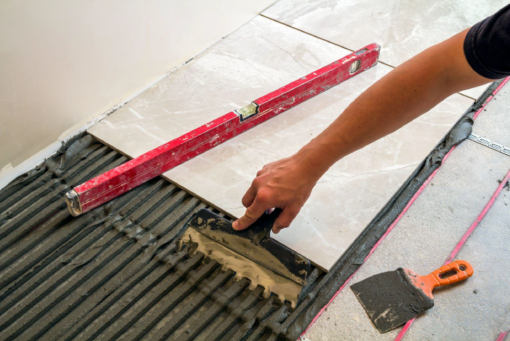
During and after installation, follow these steps to ensure the best outcome:
1. Immediate Protection: Cover newly installed and grouted tile with brown paper to shield it from debris. Dampen the grout daily during the first week to aid in curing and colour lock.
2. Grout Haze Removal: After at least 24 hours, remove grout haze with water or a grout haze remover. Avoid using harsh chemicals on natural stone products.
Safety Precautions & Maintenance
Always prioritize safety when handling tile installation and maintenance products. Test products in a small area before widespread use. Follow the manufacturer’s instructions and heed any warnings. Additionally, consider the specific needs of natural stone products, which may require different maintenance methods.
In conclusion, maintaining your tiles doesn’t have to be a daunting task. With the right products and techniques, you can keep your tiles looking pristine and attractive. Regular cleaning, proper sealing, and careful maintenance will ensure that your tiles continue to enhance your living spaces for years to come. Remember, a little effort now can lead to long-lasting beauty and functionality for your home.
Disclaimer: Tiletoria offers advice in this article for construction and renovation purposes. However, it’s crucial to recognize that this advice does not replace the expertise of certified building contractors. Each project is unique, and potential complexities vary. Readers should consult professionals before undertaking any projects. Our network of approved contractors ensures tailored guidance for safety and quality. While our article provides insights, collaboration with contractors remains vital. Contact us for assistance or connections with reputable professionals. Your project’s success and longevity are our priority.
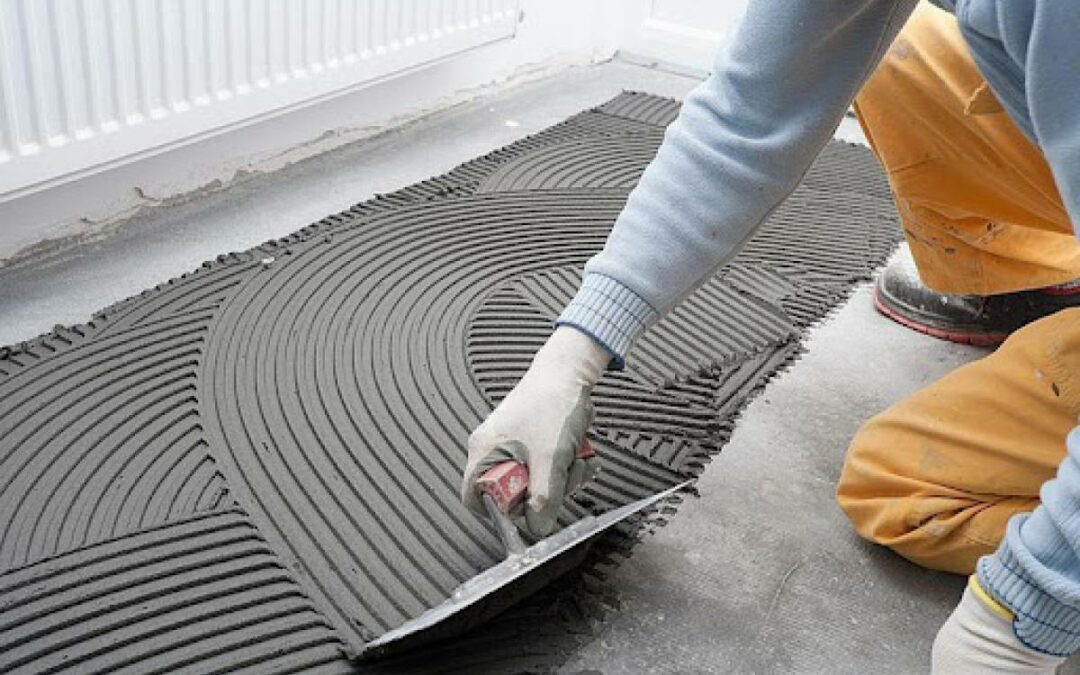
blog, commercial blog, how to articles
When it comes to tiling projects, using the right adhesive is crucial for achieving a durable and long-lasting finish. Properly applied adhesive ensures that tiles adhere securely to the surface, preventing cracks, loose tiles, and water damage.
In this comprehensive guide, we will walk you through the essential steps and best practices for using adhesives in your tiling projects, enabling you to achieve professional results and create beautiful tiled surfaces that stand the test of time.
1. Select the Right Adhesive:
Choosing the correct adhesive is the first step towards a successful tiling project. Consider factors such as the type of tiles you are using, the substrate (surface) you are tiling on, and the environment in which the tiles will be installed.
Different adhesives are formulated for specific applications, such as ceramic, porcelain, or natural stone tiles. Select an adhesive that is suitable for your specific tile type and the surface you are working on to ensure proper adhesion and longevity.
2. Prepare the Surface:
Proper surface preparation is vital for optimal adhesion. Ensure that the surface is clean, dry, and free from dust, grease, or any other contaminants. Remove any loose or uneven areas and repair them before applying the adhesive.
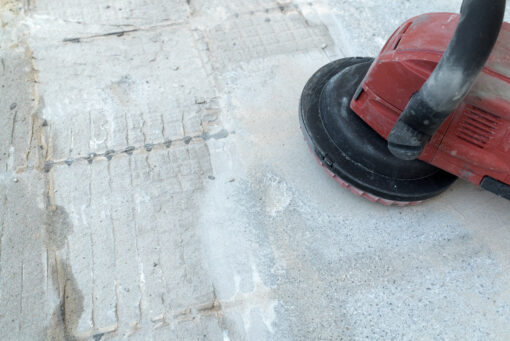
If the surface is particularly smooth or non-porous, consider roughening it with sandpaper or using a suitable primer to enhance the bond between the adhesive and the surface.
3. Mix the Adhesive:
Follow the manufacturer’s instructions to mix the adhesive correctly. Use clean water and gradually add the adhesive powder while stirring to achieve a smooth and lump-free consistency.
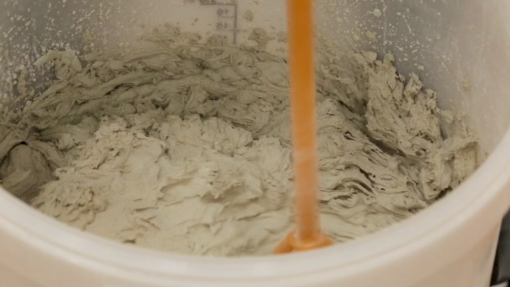
Avoid preparing more adhesive than you can use within the recommended pot life to prevent waste and ensure the adhesive remains workable.
4. Apply the Adhesive:
Using a notched trowel, spread the adhesive evenly onto the surface. The size of the notches on the trowel should be determined by the tile size and thickness, as well as the substrate condition.
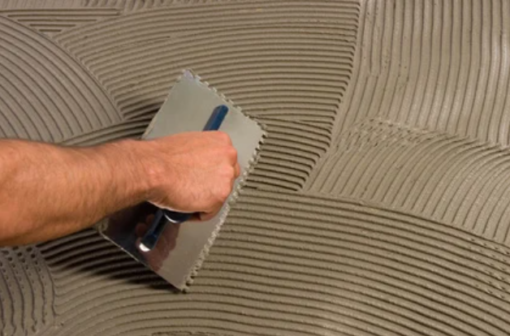
Apply the adhesive in small sections, working in manageable areas to prevent it from drying out before placing the tiles. Keep the trowel at a consistent angle to ensure a uniform adhesive bed.
5. Tile Placement:
Carefully press each tile into the adhesive, applying even pressure to ensure good contact and proper adhesion. Use tile spacers to maintain consistent spacing between tiles and achieve straight grout lines.
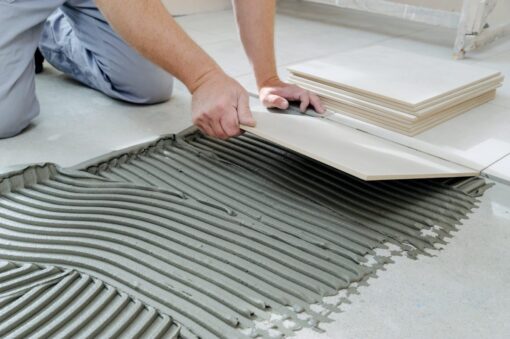
Check periodically with a level or straightedge to ensure that the tiles are aligned correctly and flush with each other. Wipe off any excess adhesive that squeezes out from the joints before it dries.
6. Allow for Proper Drying and Curing Time:
Follow the manufacturer’s instructions regarding drying and curing time. Allow the adhesive to set for the recommended period before applying grout or subjecting the tiled surface to any moisture or foot traffic.
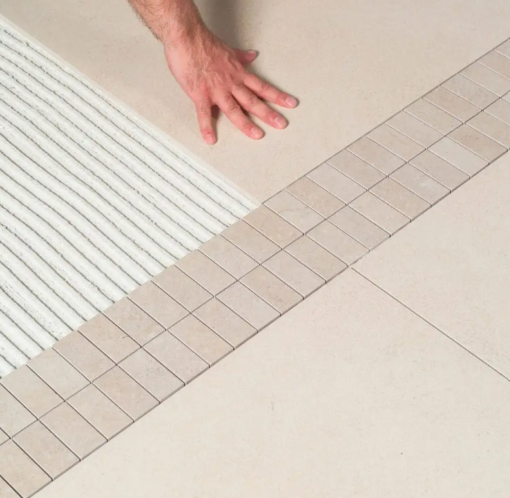
Proper drying and curing time will ensure that the adhesive reaches its maximum strength and bond.
Using adhesives for tiling requires attention to detail and adherence to proper techniques. By following this guide, you can achieve professional results in your tiling projects.
At Tiletoria, we offer a wide range of high-quality adhesives suitable for various tile types and applications. With the right adhesive and proper techniques, you can confidently tackle any tiling project and enjoy beautiful, long-lasting results.
Visit our showroom in Cape Town or Johannesburg to explore our selection and consult with our knowledgeable staff.
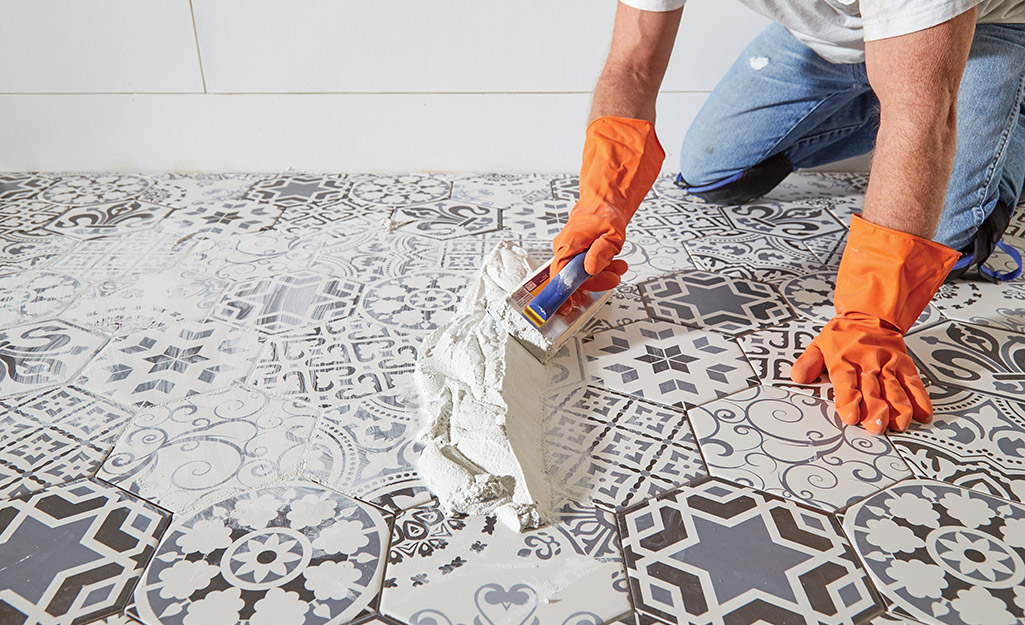
bathroom, blog, commercial blog, how to articles
Tiling a bathroom floor is a crucial step in creating the perfect bathroom. It not only enhances the aesthetics but also contributes to the functionality and durability of the space. Having a clear understanding of the steps involved in tiling a bathroom floor is essential.
In this blog, we will guide you through the process, providing professional advice to help you achieve a flawlessly tiled bathroom floor that adds charm and elegance to your space.
1. Plan and Prepare:
Before diving into tiling, proper planning and preparation are essential. Measure the floor accurately to determine the amount of tile needed. Consider factors such as tile size, colour, and pattern to ensure they complement the overall design of your perfect bathroom. Tiletoria offers a wide range of tile options, catering to various styles and preferences.
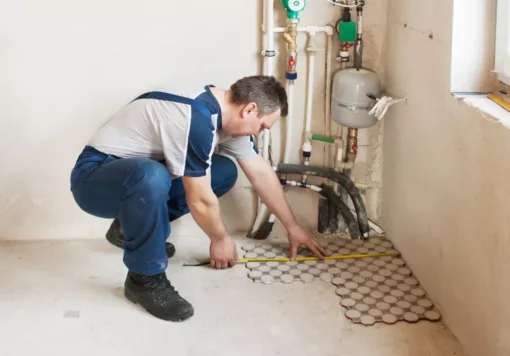
Prepare the surface by ensuring it is clean, dry, and free of any debris. If necessary, remove the existing flooring and repair any imperfections or unevenness. Tiletoria also offers a selection of high-quality adhesives and grouts specifically designed for bathroom floors, ensuring optimal results.
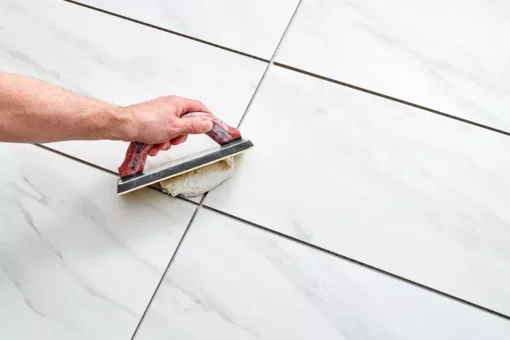
Estimating the required amount of tile and the overall cost of your project is crucial. If you’re wondering how to calculate the precise tile quantity you need, explore our blog How to calculate how much tile you need. There, we provide a detailed explanation of the step-by-step process to accurately determine the tile quantity for your specific project. By following our guidelines, you can confidently plan your project and avoid unnecessary expenses.
2. Start with a Solid Foundation: Apply Adhesive
Begin by applying a suitable adhesive to the prepared floor surface using a notched trowel. Work in small sections to prevent the adhesive from drying out before laying the tiles.
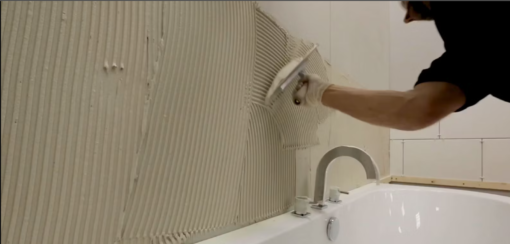
3. Lay the Tiles:
Carefully lay the tiles on the adhesive, starting from one corner of the room. Use tile spacers to maintain consistent gaps between tiles for grouting. Tiletoria provides a variety of tile sizes and styles to suit your design preferences, ensuring a personalized touch to your bathroom floor.

Take time to ensure the tiles are level and properly aligned. Use a tile cutter or wet saw to make necessary cuts for tiles at the edges or around fixtures.

4. Grout the Tiles:
Once the adhesive has fully cured, typically after 24 to 48 hours, it’s time to grout the tiles. Choose a grout colour that complements the tiles and desired aesthetic of your perfect bathroom.
If you’re unsure about how to choose the right grout colour for your tiling project, we have the perfect solution. Check out our blog on How To Choose The Right Grout Colour, where we guide you through the process of selecting the ideal grout coluor to enhance the overall aesthetic of your tiled space.
Mix the grout according to the manufacturer’s instructions, and use a grout float to apply it, ensuring it fills the gaps between the tiles completely.
Wipe off any excess grout using a damp sponge or cloth. Tiletoria offers a variety of grout options, to ensure longevity and easy maintenance of your bathroom floor.
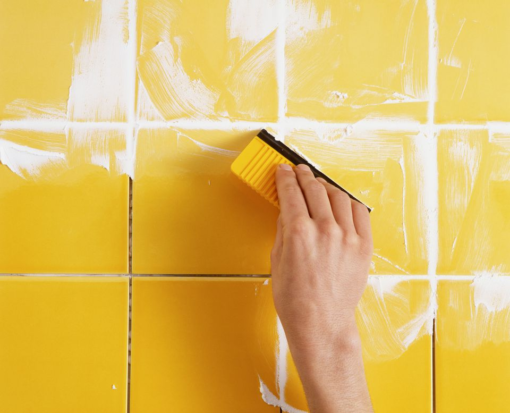
5. Finishing Touches and Sealing:
After the grout has dried for the recommended time, carefully clean the tiles to remove any grout haze. Use a suitable tile cleaner to ensure a spotless and polished finish. Consider applying a sealer to the grout and tiles to protect them from moisture and stains, enhancing the longevity of your bathroom floor. Tiletoria offer a variety of installation products to ensure your bathroom floors are affordable and resilient.

Tiling a bathroom floor requires careful planning, preparation, and attention to detail. By following our professional advice and utilizing our extensive range of high-quality tiles, adhesives, grouts, and tools, you can achieve a flawlessly tiled bathroom floor that contributes to the perfect bathroom you envision.
Take the leap and create a bathroom floor that combines functionality, aesthetics, and durability, transforming your space into a haven of beauty and style.
For more tips and advice on tiling, visit your nearest Tiletoria showroom and chat to our sales team for advice.

